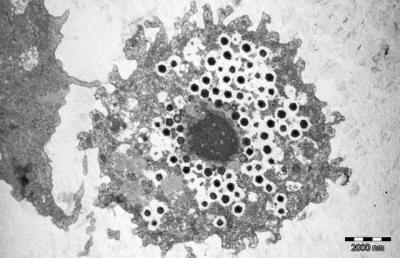|

by John Shanks
September 14, 2012
from
Sci-News Website

A new study
by a multinational team of scientists supports
the idea that viruses are ancient living
organisms and not inanimate molecular remnants
run amok, as some scientists have argued.
The
study of giant viruses, described
in a paper in the journal BMC Evolutionary Biology, may
reshape the universal family tree, adding a fourth major branch to
the three that most scientists agree represent the fundamental
domains of life.
The researchers used a relatively new method to peer into the
distant past.
Rather than comparing genetic sequences,
which are unstable and change rapidly over time, they looked for
evidence of past events in the three-dimensional, structural domains
of proteins.
“These structural motifs, called
folds, are relatively stable molecular fossils that - like the
fossils of human or animal bones - offer clues to ancient
evolutionary events,” said Prof Gustavo Caetano-Anollés of the
University of Illinois, and the Institute for Genomic Biology,
who led the analysis.
“Just like paleontologists, we look at the parts of the system
and how they change over time,” he said.
“Some protein folds appear only in
one group or in a subset of organisms, he said, while others are
common to all organisms studied so far. We make a very basic
assumption that structures that appear more often and in more
groups are the most ancient structures.”
“Most efforts to document the relatedness of all living things
have left viruses out of the equation.”
“We’ve always been looking at the Last Universal Common Ancestor
by comparing cells,” Prof Caetano-Anollés said. “We never added
viruses. So we put viruses in the mix to see where these viruses
came from.”
The team conducted a census of all the
protein folds occurring in more than 1,000 organisms representing
bacteria, viruses, the microbes known as
archaea, and all other living
things.
The researchers included giant viruses
because these viruses are large and complex, with genomes that rival
- and in some cases exceed - the genetic endowments of the simplest
bacteria.
“The giant viruses have incredible
machinery that seems to be very similar to the machinery that
you have in a cell,” Prof Caetano-Anollés said. “They have
complexity and we have to explain why.”
Part of that complexity includes enzymes
involved in translating the genetic code into proteins, he said.
Scientists were startled to find these
enzymes in viruses, since viruses lack all other known
protein-building machinery and must commandeer host proteins to do
the work for them.
In the new study, the researchers mapped evolutionary relationships
between the protein endowments of hundreds of organisms and used the
information to build a new universal tree of life that included
viruses.
The resulting tree had four clearly differentiated branches, each
representing a distinct ‘supergroup.’ The giant viruses formed the
fourth branch of the tree, alongside
bacteria,
archaea
and
eukarya (plants, animals and all
other organisms with nucleated cells).
The researchers discovered that many of the most ancient protein
folds - those found in most cellular organisms - were also present
in the giant viruses.
“This suggests that these viruses
appeared quite early in evolution, near the root of the tree of
life,” Prof Caetano-Anollés said.
“The new analysis adds to the evidence that giant viruses were
originally much more complex than they are today and experienced
a dramatic reduction in their genomes over time,” he added.
“This reduction likely explains their eventual adoption of a
parasitic lifestyle.”
The researchers suggest that giant
viruses are more like their original ancestors than smaller viruses
with pared down genomes.
They also found that viruses appear to
be key ‘spreaders of information.’
“The protein structures that other
organisms share with viruses have a particular quality, they are
(more widely) distributed than other structures,” Prof Caetano-Anollés
explained.
“Each and every one of these
structures is an incredible discovery in evolution. And viruses
are distributing this novelty.”
“Most studies of giant viruses are pointing in the same
direction. And this study offers more evidence that viruses are
embedded in the fabric of life,” Prof Caetano-Anollés concluded.
Bibliographic information
Arshan Nasir et al. Giant viruses
coexisted with the cellular ancestors and represent a distinct
supergroup along with superkingdoms Archaea, Bacteria and
Eukarya. BMC Evolutionary Biology 2012, 12:156; doi:
10.1186/1471-2148-12-156
|

